Original article published in Hydro Leader Magazine in January 2024. Click here to view.
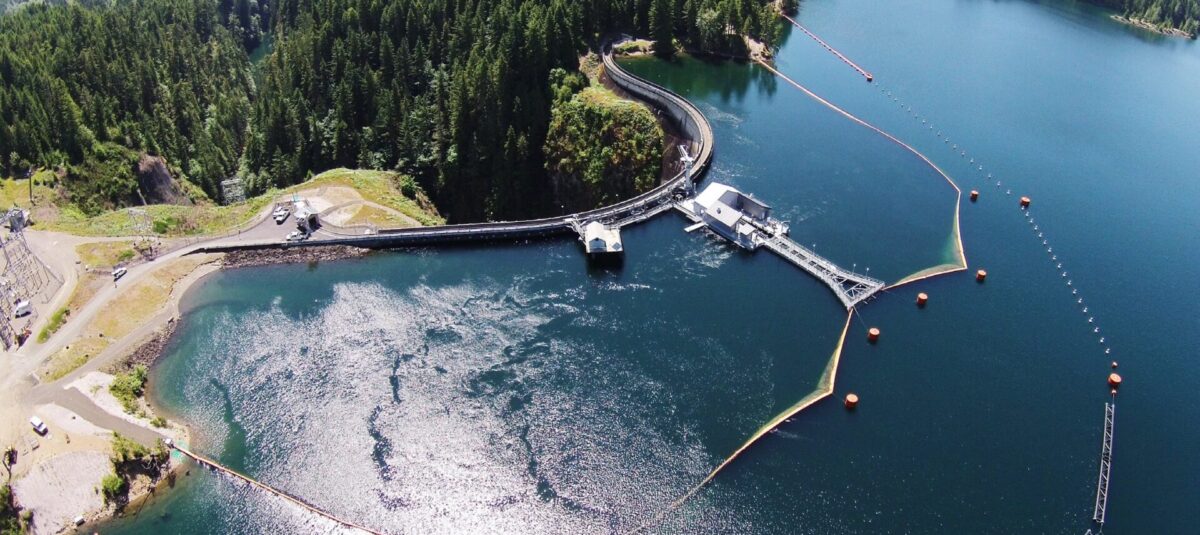
The Lake Cushman floating juvenile fish passage facility began operation in 2015 as a part of Tacoma Power’s restoration and recovery programs in the Skokomish River basin.
Tacoma Power generates, transmits, distributes, and markets energy and provides electric services for about 180,000 customers inside and outside the city of Tacoma,Washington, on Puget Sound. It also acts as a balancing authority for the load in its service territory. The utility provides its customers with 97 percent clean energy—about half from its own hydro projects and most of the rest from the Bonneville Power Administration. But its efforts to reduce its environmental impacts haven’t stopped there, says Generation Manager Chris Mattson. In this interview, he tells us about the utility’s ongoing efforts in partnership with fisheries managers to improve fisheries health and its incentive programs for home energy efficiency and conservation.
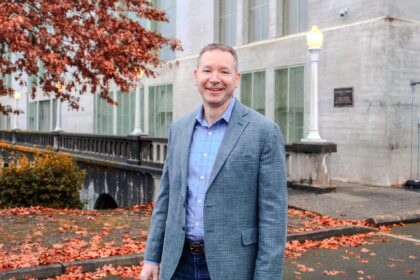
Chris Mattson, generation manager at Tacoma Power
Hydro Leader: Please tell us about your background and how you came to be in your current position.
Chris Mattson: Currently, I am the generation manager at Tacoma Power. I joined the utility in 1995 as an engineering technician. During my 28 years at the utility, I have ledupgrades on hydroelectric stations, dams, and fisheries; led the production engineering team; and been a part of the team that overhauled our largest hydro station. What I’ve found is that the hydropower industry and our organization are full of hardworking, knowledgeable, optimistic people who love to share the lessons they have learned. At Tacoma Power, there is a never‑ending array of things to learn and do, whether it is regulatory work, machinery and infrastructure maintenance, fish and wildlife efforts, or connecting with the communities we operate in. That is why I’ve stayed here and in this industry for 28 years.
Hydro Leader: Please introduce Tacoma Power.
Chris Mattson: Tacoma Power is the electric utility division of Tacoma Public Utilities (TPU), which is Tacoma’s municipal energy, water, and rail provider. TPU is the City of Tacoma’s largest department and has about 1,400 employees. The roots of TPU go back about 130 years to 1893, when the people of Tacoma decided to purchase a private power and water company. Local citizens believed that public ownership and local control would give them a higher caliber of service. The city has owned the utility ever since. Tacoma Power is a vertically integrated utility, meaning that we create, transmit, distribute, and market energy and also balance load in our service territory. We have about 180,000 customers, both inside and outside the city limits. We also own and operate several parks and campgrounds that see about 400,000 visitors a year, wildlife areas, and fish passage and rearing facilities.
Hydro Leader: What is the percentage breakdown of your energy sources?
Chris Mattson: Our energy supply is 97 percent clean and 89 percent hydropower. A little less than half that energy comes from hydro projects in Washington State that we own and operate. Most of the rest of that energy is sourced from the Bonneville Power Administration and is primarily hydro. A tiny slice of our energy supply comes from other sources, such as fossil fuel plants.
Tacoma Power owns roughly 800 megawatts of generating capacity, spread across 7 dams and 22 hydro units. We operate four hydro projects on four rivers in western Washington. The largest is the Cowlitz River Project, which produces enough clean, renewable hydroelectric energy to serve more than 151,000 homes each year. This hydropower comes from the water stored behind the Mayfield and Mossyrock Dams. During tours, I like to share that Mossyrock Dam is the tallest dam in the state from bedrock and is 1 foot taller than the Space Needle in Seattle! All our facilities are conventional hydro, and three of the hydro projects provide seasonal storage capacity with medium to large reservoirs.
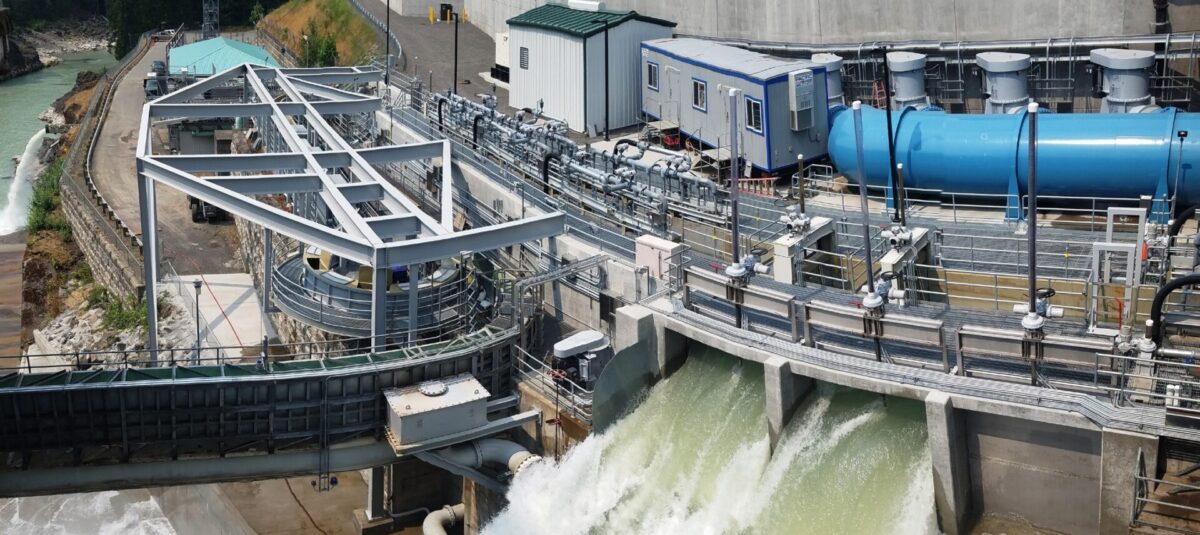
Tacoma Power’s Cowlitz Falls North Shore Collector runs through Lewis County Public Utilities District’s Cowlitz Falls Dam. The collector is helping improve juvenile fish collection rates.
Hydro Leader: What kind of fish passage do you have?
Chris Mattson: At our Cushman Hydro Project, we have a floating juvenile downstream collector. We release sockeye salmon in habitat at Lake Cushman and then pass those juveniles downstream through that facility. We also have an adult fish passage facility at the lower dam for adults returning upstream. At the Cowlitz River Project, we have two downstream juvenile fish passage facilities. One, for fish passage from a tributary at Mayfield Dam, has been there for decades. In 2017, we built a new juvenile fish passage facility upstream of Mossyrock Dam. That facility opened habitat in the upper basins of the Cispus and Cowlitz Rivers. We built that facility in partnership with another utility, Lewis County Public Utility District, which owns and operates the Cowlitz Falls Dam, and in a true testament to the strength of the partnership, we cut a hole through the utility’s dam to build the fish passage facility on the downstream shore. We continue to operate the Cowlitz Falls passage facility, which is performing quite well.
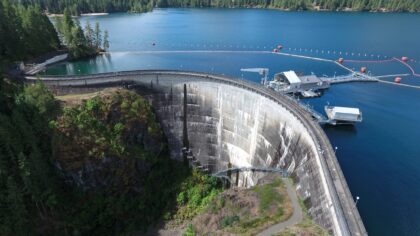
Cushman No. 1 Dam is one of two dams at Tacoma Power’s Cushman Hydro Project in Mason County, Washington. Its floating surface collector is attached to the dam and collects out-migrating juvenile fish.
Hydro Leader: Would you tell us more about the Cushman Hydro Project?
Chris Mattson: The Cushman Hydro Project was built in the 1920s and 1930s. In the 1970s, it went through a lengthy and contentious relicensing process that took about 35 years. In 2009, we reached a settlement agreement, and in 2010, we got to work on our license implementation. Just over a decade later, I am extremely proud of the progress we have made in partnership with the Skokomish Tribe and all the fisheries agencies. We built two state‑of‑ the‑art fish hatcheries and juvenile and adult fish passage facilities. Our own utility staff manage the operation of those facilities; to my knowledge, we were the first utility in the nation to operate hatcheries with our own staff. The operators of other hatcheries visit our facilities to see how we have implemented modern rearing technologies such as circular raceways. We continue to work with the fisheries managers there, the Washington Department of Fish and Wildlife, and the Skokomish Tribe to manage those programs. Under the adaptive management approach governed by our license, we recently made adjustments to our programs to begin efforts to introduce juvenile salmon in the South Fork of the Skokomish River in order to open up more habitat for the fisheries program. The North Fork is where all our hydropower operations are actually located, so to do this work in the South Fork takes a lot of trust from everyone involved.
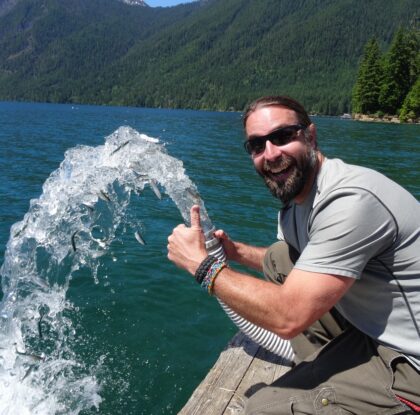
Cushman Hydro Project Fish Facilities Manager Andrew Ollenburg releasing Tacoma Power’s first juvenile sockeye into Lake Cushman in 2017. The first adult sockeye returned in 2020, and the total number of returning adults has grown every year.
Hydro Leader: Please tell us about TPU’s education and tour programs.
Chris Mattson: TPU has staff dedicated to our educational outreach program, most of which is focused on grades K–12. Our main objectives with this program are to create excitement in students, to inspire them to pursue careers at their local utilities, and to broaden the diversity of our workforce to better reflect the community that we serve. As a part of this work, our staff volunteer with local agencies such as the Boys and Girls Club to share the work they do and create excitement around the industry. We also give tours to local school districts, elected officials, and members of the public. Most of our tours are currently by request and as staff time allows.
Hydro Leader: Would you talk about Tacoma Power’s Evergreen Options and other ways that you encourage your customers to conserve energy?
Chris Mattson: Since most of our electricity comes from hydropower, it is clean, renewable, and already nearly completely carbon free. Our Evergreen Options program is a voluntary program that allows our customers to offset the carbon footprint of their homes or businesses beyond their electricity use—such as the footprint corresponding to the use of a car or the use of natural gas to heat their homes—by investing in the regional and local development of new renewable energy sources. Participants pay an additional 1.2 cents per kilowatt‑hour for a portion of their electricity, and the funds are used to purchase renewable energy certificates from regional renewable energy projects and fund our renewable energy grant program. Annually, we award at least one $50,000 grant to a local nonprofit or governmentorganization for the installation of a renewable energy project, such as a rooftop solar project. Our conservation programs incentivize customers to be energy efficient. We offer incentives for heat pump systems, hybrid water heaters, energy‑efficient windows, LED lighting, and smart thermostats. We also encourage customers to shift their energy use from nonclean forms to our clean hydropower, which they already have access to. We primarily do this by promoting the adoption of electric vehicles, which shifts customers from fossil fuels to clean energy. Currently, we have an incentive program for installing residential electric vehicle charging equipment. When you bring these things together, you both shift energy use to clean resources and keep it affordable and clean through conservation.
Hydro Leader: Would you tell us about your Low Impact Hydro Institute (LIHI) certification and what it means for your sites?
Chris Mattson: Tacoma Power first earned a certification with LIHI for the Nisqually River Project in 2003, which has been certified ever since. At that time, it was the third hydropower facility in Washington State and the eighth hydropower facility in the country to achieve the certification. LIHI is a nonprofit that certifies facilities whose impacts are low compared to other hydropower facilities based on objective scientific environmental criteria. There are eight criteria and supporting goal statements, all of which we had to meet. Applying for the certification is quite an involved process. The criteria include ecological flow regimes, water quality protection, recreational resources, and more. The certification allows us to market power from the Nisqually River Project ascertified low‑impact hydropower. Protecting and preserving our environment is one of our top priorities, and we know that’s also important to our customers and stakeholders, so we are proud to have this certification.
Hydro Leader: In what ways are you maximizing stability across your hydroelectric facilities to compete with fossil fuels?
Chris Mattson: I don’t see us as competing with fossil fuels anymore. Our state and region are moving toward 100 percent clean energy mandates, so you could say our competition is solar, wind, nuclear, and battery supply. But really, our value is realized in how we can complement, not compete with, those other forms of energy. Hydropower offers long‑term energy storage, ramping flexibility, and other grid services that intermittent renewables don’t. Over the past decade, we have continued to make small changes to extract every last ounce of flexibility from our resources. For example, we have implemented synchronous‑condensing mode on hydro units, allowing the generator to remain connected to the grid for instant ramping response without consuming any water. We added machine monitoring equipment that provided us with the data we needed to greatly expand the range of energy output, providing greater flexibility. This year, we reviewed our maintenance plans on some of our most flexible units, aiming to reduce the amount of time that a particular unit needs to be taken off the grid for maintenance. Those are just a few of the things we’ve been doing to increase the flexibility and value of our hydro stations.
Hydro Leader: Is there anything you’d like to add?
Chris Mattson: Like all forms of energy production, hydropower has impacts. For hydropower specifically, public safety is always the top priority, but beyond that, our operations involve balancing the environment, grid stability, energy production, recreation, and other benefits. It’s our job right now to continue to educate those outside our industry about that balance and the benefits of hydropower so that we can help the public and policymakers make sound decisions about the future of each of these facilities. We will likely find that some hydro developments no longer provide a net benefit, but I believe that most do and that they should be treasured by their communities.
Hydro Leader: What is your vision for the future?
Chris Mattson: The decarbonization of energy, buildings, and transportation infrastructure is going to create a lot of challenges and opportunities. The Western Interconnection will likely see some sort of centralized market that will operate more efficiently and create the economic incentives and stability that are needed to enable the construction of more clean resources and the transmission paths needed to meet the demand. I think we will see energy prices continue to rise, purely as a function of supply and demand in that environment. That will drive changes on the customer side of the meter, and as those changes occur, I believe hydro can contribute the flexibility that will be needed and will be more highly valued.

